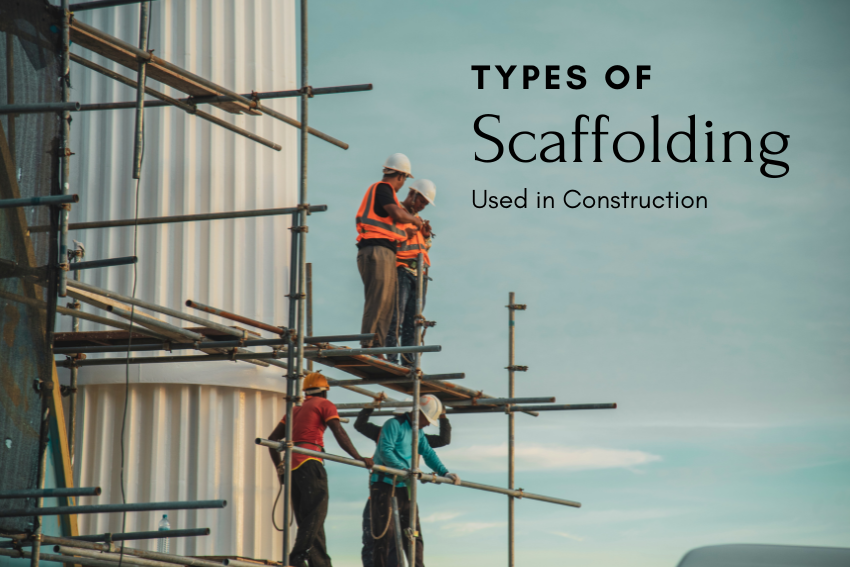Completed construction projects involve forms of temporary platforms to help people and materials at different levels. Such structures called scaffolding offer safety and access for those constructing and maintaining different types of structures. You can find many types of scaffolding that fit the job you are working on. As an example, mobile scaffolding is designed to be easily wheeled into place when you make home improvements. Suspended frames also give workers a way up to far above, using ropes attached to the ceiling.
What is Scaffolding?
In construction, scaffolding is a temporary platform that workers and materials stand on until a building or repair is finished. It helps us access difficult or risky areas by setting up a safe platform first. By considering what the work requires, scaffolding may be made differently in terms of materials, structure and how strong it must be. The decision on your product type determines its safety, usefulness and price.
10 Common Types of Scaffolding and Their Roles in Construction

Many elevated metal frames are created for specific reasons and picked depending on the building’s height and job to be done. Choosing the right types of scaffolding for your construction projects is important for both keeping staff safe and enhancing how swiftly the job is done.
Single Scaffolding – Simple and Straightforward for Brickwork
Best Use Cases: Perfect for brick masonry and smaller building projects.
Single scaffolding is the most basic form, commonly used in bricklaying jobs. It consists of vertical standards, horizontal ledgers, and putlogs that are fixed into holes in the wall. This type of scaffolding is ideal when the wall structure can support the platform directly. It’s simple, cost-effective, and best for projects that don’t need complex support systems.
Features:
- Single scaffolding is easy to set up and dismantle, making it suitable for quick jobs.
- The frame rests on the wall using putlogs, providing basic support.
- Such platform is affordable and working well for simple structures.
- As single layer design, it is not ideal for heavy loads or multi-story buildings.
- This type of scaffolding requires holes in the wall to insert putlogs for support.
Double Scaffolding – For an Extra Layer of Support
Best Use Cases: Stone masonry work or for heavier loads.
It provides greater stability than single-frame setups. A double scaffold includes two rows of standards—one near the wall and another further out—connected by ledgers and supported by putlogs laid across both frames. Workers use this setup where extra strength is required. It helps distribute weight evenly and prevents scaffolding from collapsing.
Features
- Double scaffold design avoids the need to make holes in hard surfaces like stone and ensures the entire structure stays stable during heavy-duty work.
- The frame handles rough textures and uneven surfaces better than other types. It works well for tall or large-scale projects where balance and safety are key priorities.
- Builders rely on it when the wall thickness is significant and demand more robust bracing.
- The dual-layer design enhances the load capacity of the frame and enables it to support heavier equipment.
Suspended Scaffolding – For High-Rise Maintenance
Best Use Cases: Painting, cleaning or installing windows, and repairs on a multi-floor building.
The flexible solution to work in areas where ground-supported frames are impractical. A suspended scaffold is a platform that hangs with ropes and strings attached to the roof, and workers raise or lower it as needed. It comes in different forms, but the two-point or swing stage is the most common. It consists of a deck supported by two high-strength steel cables connected to stirrups on each end that hang from the roof or building parapet. The suspended frame is also used in different setups as a temporary stage for performances.
Features
- The load carrying capacity is identified with material usage, but it typically ranges between 750 and 1500 pounds (including personnel and equipment).
- Platforms vary in length from 3 feet up to 60 feet or more. They are made of aluminum and plank or ladder-type wood.
- The suspended ropes must support at least six times the maximum intended weight. Their diameter must be sufficient for proper brake and hoist function.
- Steel is the primary material for suspension cables, outrigger beams, and support devices.
Cantilever Scaffolding – For Limited Ground Access
Best Use Cases: Bridge work, facade maintenance, and construction in narrow alleys.
The cantilever is a smart solution when construction happens above ground-level obstructions, like no space for supported frames or a busy road. It extends horizontally from a building supported by beams anchored on one end. Workers make it using steel needles that protrude from the wall instead of resting on the ground. This system eliminates the need for base-level support, which is especially useful in urban or narrow spaces.
Features
- The working surface is typically made of stainless-steel planks.
- A cantilever scaffold can be of a single or double frame, depending on the project intensity.
- Horizontal needle beams serve as primary support for distributing the load back to the main structure.
- Counterweights are placed on the opposite side of the extensions inside the building to protect against tipping and maintain balance.
Trestle Scaffolding – For Indoor Work
Best Use Cases: Interior painting, plastering, or electrical installations.
Workers use trestle scaffolds for tasks that need repetitive relocation. The setup consists of a movable stand with flat tops that support planks. It can be easily assembled and used for light-duty or low-height home tasks. The type offers a simple and cost-effective solution for maintenance projects. It is lightweight and portable, which makes the completion efficient and quicker. But it is important to remember that trestle scaffolds are unsuitable for work at greater heights, under 5m, requiring overreaching.
Features
- The frame comes in various heights and designs to suit different working levels.
- The platform rests on the trestles to create a flat and stable working surface.
- The scaffold usually supports loads up to 225 kg per platform for light duty. Wider planks with widths ranging from 450mm to 900 mm are used for medium—and heavy-duty tasks.
- Diagonal supports connect the trestles to enhance the overall stability of the structure.
Mobile Scaffolding – For Flexible Access
Best Use Cases: Indoor maintenance tasks or drywall installation.
It provides workers with a stable platform that can easily move from one location to another. Manufacturers design mobile scaffolds with wheels or castors at the base to easily reposition them without dismantling the entire structure. The system works best on smooth and flat surfaces—such as tiled or concrete floors—where the wheels can roll safely and steadily. But do not forget to lock the casters before standing on the structure. This prevents unwanted movement and ensures the platform stays fixed while in use.
Features
- The setup includes:
- Narrow frame scaffolds are often used as mobile structures with end frames measuring 3 feet or less in width.
- Full-sized H-frame mobile towers are more suited for larger or higher jobs.
- Platforms on the frame support between 225 kg and 675 kg, but dimensions vary to suit different tasks and spaces. They must not extend beyond base supports unless stability is ensured with outrigger frames.
- Mobile frames have height limitations of not more than 4:1 (height-to-base ratio). They may not support heavy loads and require workers to always follow weight restriction guidelines.
- Most models feature a lightweight aluminum frame, which makes them easy to transport and assemble. You don’t need any special tools or heavy machinery to set them up.
Supported Scaffolding – For a Reliable Base
Best Use Cases: Construction and repair work.
Construction teams rely on supported scaffolds for strength during a wide range of building tasks. These frames stand directly on the ground or a solid base with vertical supports called standards to carry the entire load. To create a strong framework, workers erected it by rigid means such as poles, legs, frames, or similar. The setup can be either fixed in one place or designed with added mobility. You will often see supported scaffolds at renovation, residential, or commercial projects. They work well for both low-rise and multi-story buildings, but the only requirement is sufficient ground space.
Features
- The supported elevated platforms are available in different types:
- Tube and Coupler scaffold
- Frame scaffold
- System scaffold
- Rolling scaffold
- Each component of the scaffold must support its weight and the maximum intended load.
- The structure features guardrails and toe boards for enhanced safety. It is erected with load-bearing components and mud sills for a balanced foundation.
Steel Scaffolding – Built Strong for Big Jobs
Best Use Cases: Best for high-rise buildings and heavy-duty construction.
Steel scaffolding is made from steel tubes joined together with clamps or fittings. It’s strong, fire-resistant, and ideal for tall buildings or long-term projects. Though more expensive than wood-based scaffolding, it offers great safety and durability, which makes it a smart choice for demanding construction environments.
Features:
- Steel scaffolding has a strong metal frame that can support heavy loads.
- The frame stands up well to fire and rough weather conditions.
- As made from steel, it can be reused many times, making it cost-effective over time.
- The structure provides a stable platform for working at great heights.
- The scaffold requires trained workers to assemble and maintain properly.
Bamboo Scaffolding – For Natural Strength
Best Use Cases: Small and large-scale projects
This temporary structure is made of bamboo and nylon straps and is commonly used in the construction industry in many parts of Asia. Bamboo framing is known for its rapid assembly and disassembly compared to steel and aluminum. It works especially well for low—to mid-rise buildings and even higher projects. Builders construct it by tying bamboo poles together to create vertical squares. They provide support and act as ladders for workers. Bamboo grows quickly and is widely available, which makes it a sustainable alternative.
Features
- Bamboo scaffold supports significant loads when tied and braced properly. It handles strong winds and vibrations with resilience.
- The type provides a lightweight and cost-effective solution where steel scaffolding is expensive and not available. Its flexibility makes it adaptable to different construction site contours.
- Skilled workers can quickly set up the frame and adjust it to fit complex architectural designs. They customize platforms with bamboo or wooden planks to create working surfaces.
- The high tensile strength of the material allows these scaffolds to support moderate loads.
Kwikstage Scaffolding – Fast to Set Up, Built for Flexibility
Best Use Cases: Ideal for large, fast-moving construction projects.
Kwikstage scaffolding is a modern modular system that allows for quick assembly and breakdown. It uses prefabricated parts that lock into place, making it both safe and efficient. This system is widely used in projects that need speed and flexibility, including buildings with unusual shapes or tight schedules.
Features:
- Kwikstage scaffold clicks together easily, reducing setup time significantly.
- The structure fits different building shapes, thanks to its modular design.
- The structure has fewer loose parts, making it safer for workers.
- Each component of the scaffold is built to handle tough construction environments.
- The scaffold can be reused on multiple projects with minimal wear.
Conclusion
Scaffolding is designed to meet specific site requirements. Whether you’re dealing with limited ground space or handling routine maintenance tasks, it provides a safe elevated workspace to get your job done. Double and supported scaffolds offer enhanced stability for heavy-duty and high-elevation work, while mobile and trestle frames are ideal for indoor maintenance due to their portability. Bamboo platforms are an eco-friendly and strong framework option, though they remain uncommon in many parts of the world.
With different setups and assemblages, all scaffolds serve the same purpose of getting access to unreachable areas in a distinct way. Always priorities your safety and quality by consulting with an experienced scaffolder to select the suitable choice based on your project load and height requirements.






